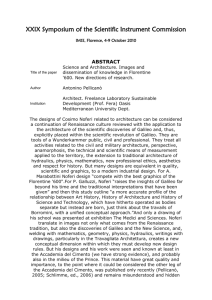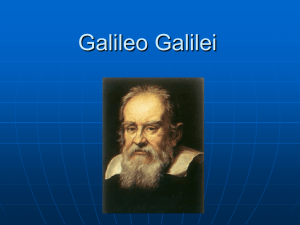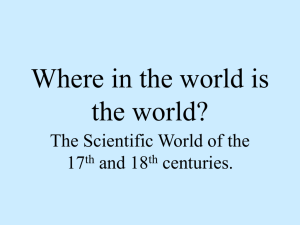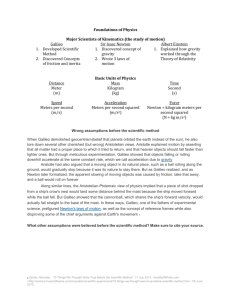PHY1033C/HIS3931/IDH 3931 : Discovering Physics: Fall 2015 Prof. Peter Hirschfeld, Physics
advertisement
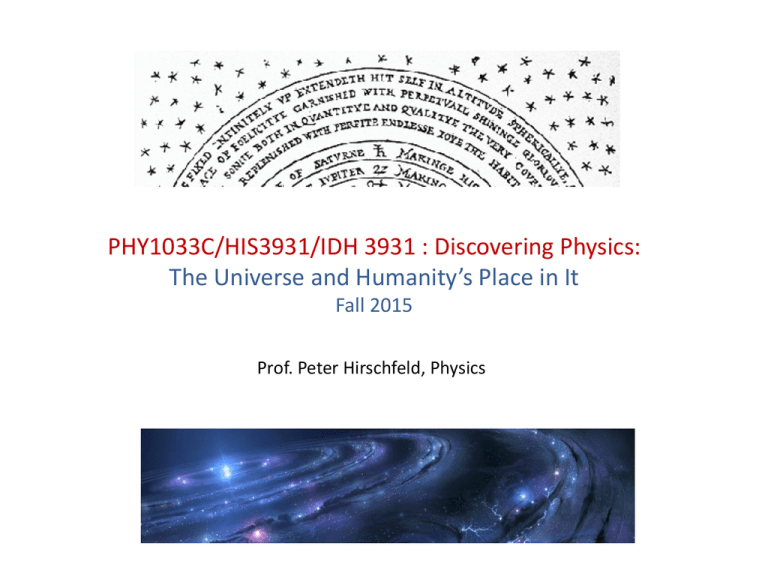
PHY1033C/HIS3931/IDH 3931 : Discovering Physics: The Universe and Humanity’s Place in It Fall 2015 Prof. Peter Hirschfeld, Physics Announcements • Reading this week: Gregory, Chapter 6 Observations of the moon, The satellites of Jupiter, Galileo's Theory of the Tides, Excerpts from The Dialogues • Results of midterm survey • Test announcements Midterm exam • In class Thursday, Oct. 15 • Covers all material up through end of Week 7 (2/19) • Bring: ID, scratch paper (calculator optional) • Format: 30% mult. choice 40% short answer 30% essay (choice of 2) • Review 1 (primarily math): NPB 2205 6pm Monday 10/12 • Review 2: (overall review): NPB 2205 5:30pm Wednesday 10/14 •1 side paper “cheat sheet” (handwritten) allowed Highlights of midterm survey & responses (more complete summary posted on web page) 1. Overall pace, organization, lectures (+ office hours) • • • • • Pace/level: just right: too slow: 0 Organization: good, with suggestions Lectures: generally good Content: good, a few said too much math/physics Office hours: good Responses: Not a history class, not a physics class, both Even traditional hist. of science requires understanding scientific principles Recall: Review session for exam (primarily math/phys) 2. Homework • • Overall: fair, reasonable: 6 confusing, questions sometimes unclear stimulating 3 fit well with reading 3 Unprepared for math/physics questions (a few) Responses: 1) Trying to work on right mix of physics/history, making questions clearer. 2) If you’re confused, please attend ofc. hrs. OR make an appt. OR send an email. Glance at HW early to make sure you understand question. 3. Lab • Overall: fair, interesting, but fun! length ok grading too harsh: 2 too hard: 2 Responses: 1) Questions about grading: sit down with Todd/me 4. General comments • Pre-lecture recap helpful! • Can we please access our grades? Responses: 1) Grades will be posted later this week on canvas That contemplative PHY1033C/HIS3931/IDH3931 feeling Last time Galileo’s ideas about earthly motion: • Falling bodies: no leaning tower, didn’t really believe all bodies fall at same rate (initially) Didn’t believe Aristotle either: “thought expt.” • Real expts: - pendulum: period T independent of amplitude length l T2 - using inclined planes showed y t2 - results gave him confidence to apply math to earthly realm Galileo showed that projectiles have parabolic motion t=time in air G’s measurements showed that heights y x2 (parabola) ranges x t consistent with y t2 G analyzed motion in terms of composite (“double”) motion in both x and y simultaneously. Taken together, two observations imply y t2 as before The actual logbook! Importance of Galileo’s approach to understanding motion: 1st combined use of empirical measurements and mathematical analysis to study earthly motions (motion of objects on the Earth)! By timing a swinging chandelier in the Pisa cathedral with his pulse, Galileo noticed 1. The period of the chandelier was independent of the length of the cord it hung from 2. The chandelier never stopped swinging 3. The amplitude of the chandelier’s oscillation (size of the oscillation back & forth) was proportional to its mass 4. The amplitude was inversely proportional to its period 5. The period of the chandelier was independent of the amplitude Galileo deduced laws about falling bodies from inclined plane experiments 1. using a coating of ice to minimize friction 2. because he could slow down the motion and get better accuracy 3. because he was forbidden to use the leaning tower of Pisa due to his Copernican views 4. because he wanted to prove Aristotle’s predictions right 5. because Giovanni de Medici had asked him to build a roller coaster in Florence Galileo heard about a new invention Built one and turned it on the heavens Publishes The Starry Message (in Latin) March 1610 Observed three things Moon had rough surface Many more stars than thought Jupiter had moons Was a sensation To Florence, 1610, as court philosopher to Cosimo II By end of the year he’d discovered a new phenomenon The phases of Venus But… according to Ptolemy Venus can’t have phases Venus would show phases in a Copernican system But so would it in a Tychonic system So, while Venus’s phases do disprove Ptolemy, they don’t prove Copernicus Galileo is invited to Rome where he is celebrated for his achievement Between 1610 and 1616 Galileo chooses to ignore Tycho’s system Even though he cannot prove the earth’s motion, he begins more and more to tout the truth of Copernicus It’s not long before people begin to assume that Galileo backs Copernicus There are those within the church who wonder Already in 1611 an advisor to the pope had asked mathematician colleagues about Galileo’s observations Answer: Jupiter’s moons and Venus’s phases are solid. Not sure about stars and surface of the moon Others worried if Galileo’s claims square with Scripture? In this church in (Santa Maria Novella) in 1613 Thomasso Caccini denounced Galileo’s view as incompatible with Scripture and later forces the issue with the church hierarchy In 1616 Galileo decided to go to Rome to clear things up Things do not go as anticipated The pope appointed a commission to advise him, which resulted in a general prohibition for everyone against holding a Copernican view In a famous meeting with Bellarmine Galileo was told he could not hold or defend the Copernican view Others were present, but it’s not clear what if anything they said to Galileo Cardinal Robert Bellarmine To quell rumors, Galileo obtained an affidavit from Bellarmine confirming that he had not been condemned In 1620 Galileo’s protector, Grand Duke Cosimo II, died at the age of 30 Ferdinando II Cosimo II The new grand duke was only an adolescent, so Tuscany was ruled by his mother and grandmother until he came of age in 1628 Galileo now comes up with an answer to a major objection to Copernicus Why don’t we sense the motion of the earth? Develops a new physics of motion Aristotle was wrong – not all motion requires a mover Uniform motion in a perfect circle is a natural state “Inertial motion” is a state of being equal to rest Galileo: Uniform circular motion will, like rest, continue forever unless interrupted If rest and (uniform circular) motion are equivalent states of being, then our experience will be the same at rest as in uniform motion – I can’t be sure if I’m at rest or in motion unless I can detect another frame of reference – motion is relative Galileo’s own notion that motion could be uniform and unending applied really only to circular motion at the Earth’s surface! He didn’t quite get to idea that motion would continue in straight line unless something changed it (Newton) Galileo: you can’t tell you’re moving in a ship because it is going around the Earth in uniform circular motion Modern view: a “reference frame” moving at constant velocity can’t be distinguished from any other reference frame, incl. one at rest! Still we call this principle “Galilean relativity” Revisit old problem posed by Ptolemy and others: throwing a rock up when Earth is spinning vrock vrock,x vrock,x vrock,x vEarth Q: what property of an object makes it stay going in straight line, resist friction, air resistance, etc.? Inertia: the tendency of an object to resist changes to its state of motion (including rest!) Equivalent to mass! Galileo also tried to develop a proof that the earth moved – his theory of tides N.B. Kepler had already pointed to Moon as causing tides via something akin to gravitation! In 1623 Galileo’s friend, Mafeo Barberini, was elected pope Pope Urban VIII Galileo visited him in 1624 and again in 1630 Urban knew Galileo was working on a new book dealing with Copernicus Urban had 2 requirements Must treat Copernicus as hypothesis Must not title the book On the Ebb and Flow of the Sea Galileo was in Rome in 1630 to work out the details about his publishing his work Galileo believed he could meet Urban’s first requirement by creating a discussion among three interlocutors Eventually he was able to get church representatives to sign off on the book In the course of these negotiations, Galileo did not mention anything about the meeting with Bellarmine in 1616 The book came out in February of 1632 as Dialogues on the Two Chief Systems Of the World Galileo’s critics soon persuaded the pope something had to be done The trial began in April of 1633 and turned on documents from 1616 Galileo was convicted of Heresy and recanted his Belief in the Copernican system He was not tortured, but Placed under house arrest Galileo’s tomb in Sante Croce What happened in 1616? After hearing the commission’s report the pope was specific about what was to be done “Thursday, 25 February 1616. The Lord Cardinal Mellini notified the Reverend Fathers, the Assessor, and the Commissary of the Holy Office that the censure passed by the theologians upon the propositions of Galileo—to the effect that the Sun is the centre of the world and immovable from its place, and that the Earth moves, and also with a diurnal motion—had been reported; and His Holiness has directed Lord Cardinal Bellarmine to summon before him the said Galileo and admonish him to abandon the said opinion; and, in case of his refusal to obey, that the Commissary is to enjoin on him, before a notary and witnesses, a command to abstain altogether from teaching or defending this opinion and doctrine and even from discussing it, and, if he does not acquiesce therein, that he is to be imprisoned.” In a meeting of the Holy Office of March 3, 1616 Bellarmine reported on his meeting with Galileo “The most illustrious Lord Cardinal Bellarmine having given the report that the mathematician Galileo Galilei had acquiesced when warned of the order of the Holy Congregation to abandon the opinion which he held till then, to the effect that the sun stands still at the center of the spheres but the Earth is in motion” It would seem that an intervention by the commissary was unnecessary But, according to disputed document Friday, the twenty-sixth. At the palace, the usual residence of Lord Cardinal Bellarmine, the said Galileo, having been summoned and being present before the said Lord Cardinal, was, in the presence of the Most Reverend Michelangelo Segizi of Lodi, of the order of Preachers, Commissary-General of the Holy Office, by the said Cardinal, warned of the error of the aforesaid opinion and admonished to abandon it; and immediately thereafter, before me and before witnesses, the Lord Cardinal being present, the said Galileo was by the said Commissary commanded and enjoined, in the name of His Holiness the Pope and the whole Congregation of the Holy Office, to relinquish altogether the said opinion that the Sun is the center of the world and immovable and that the Earth moves; nor further to hold, teach, or defend it in any way whatsoever, verbally or in writing; otherwise proceedings would be taken against him by the Holy Office; which injunction the said Galileo acquiesced in and promised to obey. Done at Rome, in the place aforesaid, in the presence of R. Badino Nores, of Nicosia in the kingdom of Cyprus, and Agostino Mongardo, from a place in the Abbey of Rose in the diocese of Montepulciano, members of the household of said Cardinal, witnesses. Did the church forge this document at the time of the trial? No All the documents are in the same handwriting Why would the church create a document that showed the the pope’s instructions had not been followed in 1616? In other words, the church did not agree that the work was hypothetical Galileo was guilty of holding and defending Copernicus



